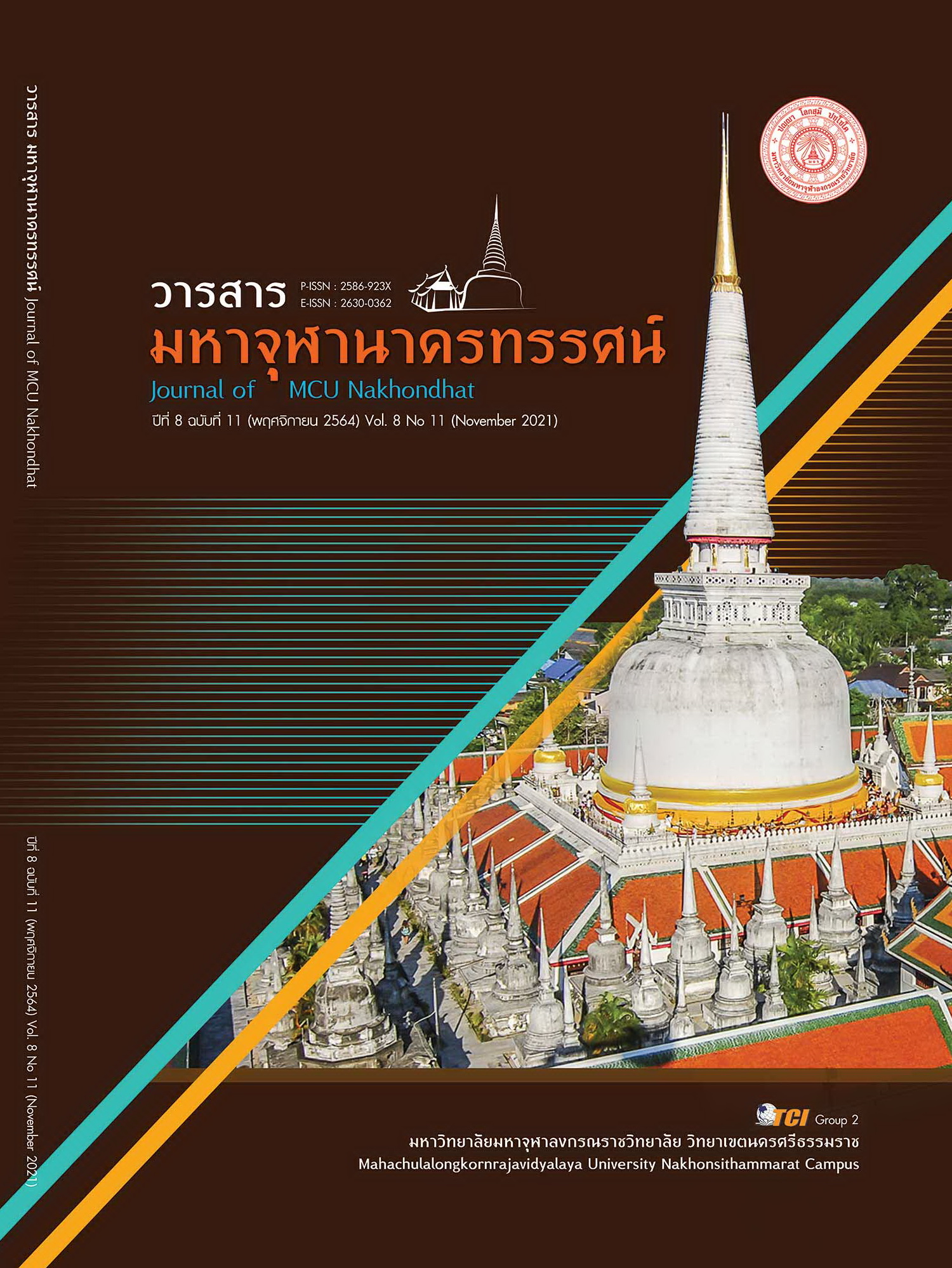THE EFFECTS OF BLENDED LEARNING METHOD TO ENHANCE LEARNING AND INNOVATION SKILLS IN 21ST CENTURY IN PROFESSIONAL PHOTOGRAPHY COURSES OF MATHAYOMSUKSA 3 STUDENTS
Main Article Content
Abstract
The objectives of this research article were: 1) to study effects of blended learning method to enhance learning and innovation skills in the 21st century of learners in professional photography courses, 2) to compare their learning and innovation skills in the 21st century before and after the use of the blended learning method, and 3) to evaluate the learners’ satisfaction with this method. This study was conducted in the first semester of the academic year 2021. This study were quasi - experimental research one-group: pretest posttest design. The target group comprised of 30 students in mathayomsuksa 3 at Surasak Montree School, Bangkok province. The research instruments consisted of 1) lesson Plans, 2) an evaluation form on learning and innovation skills in the 21st century, and 3) a learner satisfaction questionnaire. The obtained data were analyzed by using mean and standard deviation. The results of the study were as follows: 1) the blended learning method combined four teaching methods: lectures, discussions in the classroom, and integrated with self-directed study such as group assignments on searching and reporting, using networking and studying questions, creating videos, creating magazine cover and e-books; 2) the learners’ learning and innovation skills in the 21st century higher using this method; and 3) their learning and innovation skills in the 21st century were evaluated by the researcher-instructor at a high level after using this method; and 4) the learners’ average score of satisfaction with the learning method was at the high level.
Article Details
References
ธานินทร์ ศิลป์จารุ. (2549). การวิจัยและวิเคราะห์ทางสถิติด้วย SPSS (พิมพ์ครั้งที่ 5). กรุงเทพมหานคร: วี.อินเตอร์ พริ้นท์.
ปณิตา วรรณพิรุณ. (2553). รายงานวิจัยเรื่องการพัฒนารูปแบบการเรียนแบบผสมผสานโดยใช้เครื่องมือทางปัญญาเพื่อพัฒนาทักษะการคิดอย่างมีวิจารณญาณ. กรุงเทพมหานคร: มหาวิทยาลัยเทคโนโลยีพระจอมเกล้าพระนครเหนือ.
พลอยไพลิน ศรีอ่ำดี. (2556). ผลการจัดการเรียนรู้แบบผสมผสานด้วยกิจกรรมการเรียนแบบแก้ปัญหาวิชาเทคโนโลยีสารสนเทศ 2 ที่มีต่อความสามารถในการแก้ปัญหาและผลสัมฤทธิ์ทางการเรียนของนักเรียนชั้นมัธยมศึกษาปีที่ 2 โรงเรียนสิรินธรราชวิทยาลัย. วารสารวิชาการ Veridian E-Journal., 6(2), 582-596.
สำนวน คุณพล. (2560). การจัดการเรียนรู้วิชาคณิตศาสตร์ตามทฤษฎีการสร้างความรู้ด้วยตนเองโดยการสร้างสรรค์ชิ้นงานวีดิทัศน์ สำหรับนักเรียนระดับชั้นมัธยมศึกษาปีที่ 1 โรงเรียนสาธิตแห่ง มหาวิทยาลัยรังสิต. เอกสารนำเสนองานวิจัยทางการศึกษา การประชุมทางวิชาการ ครั้งที่ 7 คณะศึกษาศาสตร์มหาวิทยาลัยรังสิต, 26 กุมภาพันธ์ 2560, 75 – 89.
สุมาลี จันทร์ชะลอ. (2542). การวัดและประเมินผล. กรุงเทพมหานคร: ศูนย์สื่อส่งเสริม กรุงเทพ.
สุสัณหา ยิ้มแย้ม และคณะ. (2558). การพัฒนาการจัดการเรียนรู้แบบผสมผสาน เพื่อพัฒนาทักษะการเรียนรู้ในศตวรรษที่ 21. พยาบาลสาร, 42(พิเศษ),129-140.
อดุลย์ วังศรีคูณ. (2557). การศึกษาไทยในศตวรรษที่ 21 : ผลผลิตและแนวทางการพัฒนา. วารสาร มนุษยศาสตร์และสังคมศาสตร์ บัณฑิตวิทยาลัย มหาวิทยาลัยราชภัฏพิบูลสงคราม, 8(1),1-17.
Allen, I.E. et. al. (2007). Blending In: The Extent and Promise of Blended Education in the United States. Needham, MA: The Sloan Consortium.
Eryilmaz, M. (2015). The Effectiveness of Blended Learning Environments. Contemporary Issues in Education Research, 8(4), 24-31.
Mohammed Mohammed Nasser Hassan. (2015). Perceptions and Attitudes towardsBlended Learning for English Courses: A Case Study of Students at University ofBisha. English Language Teaching, 8(9), 40-50.
Shivam, R. (2015). Implementation of Blended Learning in Classroom: A review paper. International Journal of Scientific and Research Publications, 5(11), 369-372.
The partnership of 21st Century Learning. (2009). P21 Framework Definitions. Retrieved 2020 5, December , from www.p21.org/storage/documents/ P21_ Framework_Definitions.pdf


